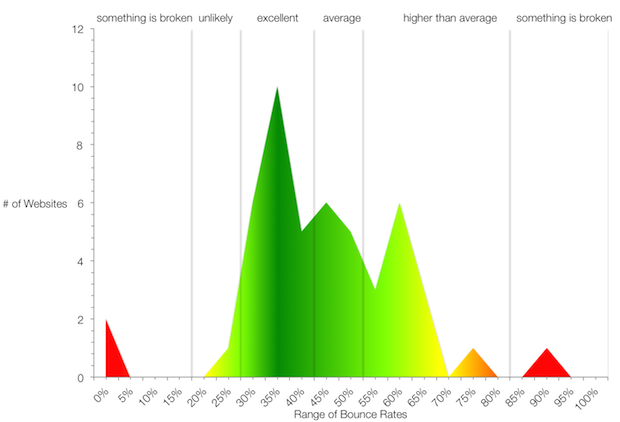With the proliferation of analytics tools online, there exists an endless array of statistics and metrics that you can view to track every aspect of your website’s performance. One of the most telling, and useful, of these indicators is bounce rate.
Bounce rate refers to the percentage of visitors who navigate away from your site after viewing only one page. Since the goal for almost any website is to draw users in and get them to click around — whether to browse the online store, or consume more content, or fill out a contact form — the benefit in lowering this figure is obvious.
We’ll serve up some suggestions on how to accomplish that in just a bit, but first, we’ll help you familiarize yourself with what a typical bounce rate looks like, and what an unusually high number means for your website.
What is a Typical Bounce Rate?
This can vary substantially across different types of sites (single-page destinations such as a blog post or lander will usually have higher rates), but as a general rule, the breakdown looks like this:
50% or less: Good
50%-75%: Average
75% or more: Bad
The Rocket Fuel blog published this graph to provide a visual representation of the range of bounce rates:
You’ll almost never see a bounce rate below 20 percent, but getting somewhere around two out of every three visitors to click onto another page is a realistic and feasible goal for most websites.
What Does a High Bounce Rate Mean?
A higher than average bounce rate means you’ve got some work to do in order to better engage visitors and draw them into your site after landing on the first page. We’ll offer up some strategies to improve your rate below. But an extremely high bounce rate — like 85 percent or above — probably means one of two things.
First, there may be a technical problem with your site. It could be a design flaw, a usability issue, a loading malfunction, or something along those lines. When you see a sky-high bounce rate, you’ll want to thoroughly review your site from a user experience standpoint and ensure that everything is working properly.
The other likely possibility is that you’re simply not delivering what visitors are looking for. If someone arrives at your site from a search engine or a link on social media and leaves immediately, chances are they were expecting to find a particular type of information or product and it simply wasn’t there. In this case, you need to re-evaluate your site’s content and make sure it matches up to what you’re advertising.
How Can I Lower My Bounce Rate?
Improve site’s layout and design
Sometimes even if the content on a site is good, visitors will quickly be turned away by a layout that is confusing or unintuitive, or by a design that is unprofessional. Make sure that the copy on your page is easy to read — large text that contrasts with the background and isn’t presented in huge, daunting chunks. Avoid using weird fonts that might be difficult to read. Include lots of headers and bullets to keep everything organized and very digestible. And make sure that you have a pro handling your design, because most users won’t waste their time with a site that looks like it was created by an amateur.
Present clear and compelling calls to action
If you want people to click around your site, you’ve got to give them something worth clicking on! Big, colorful buttons that incite some sort of action — such as providing an email address, or registering for a free quote, or viewing a list of your services — will capture the eyes of a visitor and perhaps pique their curiosity. The more creative you can get with these calls to action, the better.
Offer related content and products
Give the people (more of) what they want. If they came to your page to find a particular product, suggest other products they might like. If they came to read an article or blog post, offer a list of articles on related topics.
Alter your keyword strategy
If you’re getting a high number of bounces from individuals that are finding your site via search results, it’s a sign that people aren’t finding what they’re looking for when they click on your page after performing a search. In all likelihood, that’s because the keywords you’re focusing on in your search marketing strategy aren’t effectively representing what is on the page. The benefit to having accurate keywords is twofold, because in addition to lowering your bounce rate, your organic SEO will improve as search engines notice that users who are clicking on your site for particular queries are sticking around (and thus, finding what they’re looking for).
Make sure your site is mobile-friendly
This is an increasingly prevalent issue with retaining traffic. More searches now come from mobile devices than desktop computers, so sites that lack an adaptive and responsive design are losing their visitors in a hurry. If your site doesn’t look good and function well on a phone or tablet, that’s something that needs to be remedied as quickly as possible.
Increase your page’s load speed
If a site is too slow to load, users will often lose patience and exit rather than waiting around. There are several factors that can contribute to poor load speeds, but chief among them is too many multimedia elements — such as Flash animations, videos or GIFs. There’s a balance to be struck, because those elements can also offer a lot of benefits, but try to limit the number of media components on pages that serve as primary entry points.
Set up external links to open in a new window
This is a fairly simple strategy. When linking to pages outside of your own domain, set them to open in a new window, so that your website will remain active in the background and the user can (hopefully) return and navigate around more of your pages. Most content management systems (CMS) will have an easily identifiable “Open in New Window” option when you add a link.
We Can Help
At Top Source Media, our experts are well versed in assessing bounce rates and helping to bring them down, through the methods mentioned above as well as others. Fill out our contact form and let us know what your company’s goals are, and we’ll tell you how we can help!


